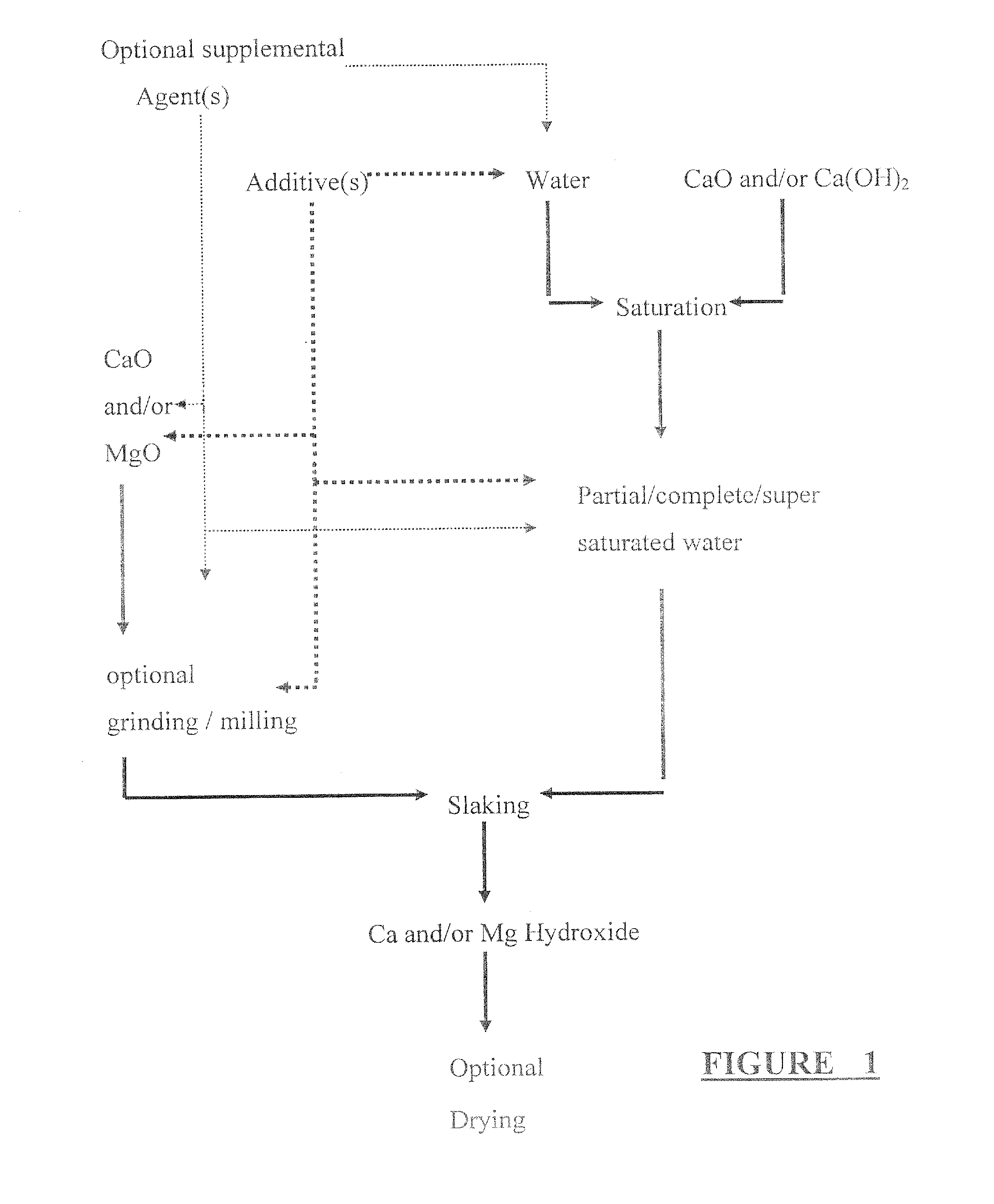Calcium and/or magnesium hydroxide with very high reactivity, and preparation thereof
a magnesium hydroxide and high reactivity technology, applied in the field of hydrated lime, can solve the problems of limited reactivity, inability to give a comprehensive definition, and relatively poorly soluble lime in water, so as to prevent or reduce possible carbonatation, the effect of reducing the free water conten
- Summary
- Abstract
- Description
- Claims
- Application Information
AI Technical Summary
Benefits of technology
Problems solved by technology
Method used
Image
Examples
use-example 1
[0121]This example concerns the production of sand-lime bricks. Four tests were carried out, three with calcium hydroxides (A, B and C) produced from the same ground quicklime. A fourth test performed with this ground quicklime constitutes the control test and corresponds to the traditional way of using lime
[0122]These four tests were carried out in the laboratory with equal concentrations of available CaO in all tests, viz, 7% by weight in relation to the moist sand, and under identical conditions described below:[0123]Mixing moist (8%) silica sand lime in a planetary mill for 5 minutes.[0124]Allowing the mixture to stand at 70° C. for 3 hours.[0125]After readjustment of the water content of the mixture to 6%, forming was effected by pressing in a cylindrical mould 50 mm in diameter and 50 mm high. The quantity of material inserted in the mould corresponded to a material density of the cylindrical prism of 1.8 g / cm3 or, for a volume of 98,175 cm3, 176.715 g of a moist mixture of hy...
use-example 2
[0130]This example concerns the treatment of acid gases with calcium hydroxide and more particularly the neutralization of the hydrochloric acid content of fumes arising from the incineration of household waste, by injection of hydrated lime.
[0131]Laboratory tests were carried out with calcium hydroxides A (comparative), B (comparative) and C (invention) under identical conditions in order to compare their performance in neutralizing gaseous hydrochloric acid.
[0132]The tests were performed in a fixed bed. The limes had been rendered into granules with an average diameter of 3 mm, to enable the acid gas to pass freely through the bed. Granulation was performed with an Eirich granulating mixer by intensive mixing at a moisture level of 15%. After treatment, the granules were dried and screened between 4 and 5 mm. The intra- and inter-granular porosity afforded intimate contact between the gas (HCl) and the solid (Ca(OH)2).
[0133]The temperature of the granule bed was maintained at 160°...
use-example 3
[0139]In the field of stabilization of clayey-oozy soils, the notion of reactivity is underrated. Just as in the manufacture of sand-lime materials, these solid / solid reactions require very high reactivity of the lime in order that losses of reagent can be limited and good yields obtained. Traditionally a quantity of 2% of powdered quicklime is incorporated into the soil at a temperature that is often below 20° C. Hydration of the calcium oxide in contact with the moisture in the soil therefore takes place under conditions highly unfavourable to the production of the reactive calcium hydroxide needed for reactions with argillaceous minerals. Quite apart from the very low temperature of reaction, the H2O / CaO ratio and the presence of humic acid and mineral salts in the soil will have a very negative effect on the hydration process. For these reasons, only short-term reactions, that is to say those lasting under 2 hours, are taken into consideration. The beneficial long-term effects r...
PUM
| Property | Measurement | Unit |
|---|---|---|
| Temperature | aaaaa | aaaaa |
| Temperature | aaaaa | aaaaa |
| Temperature | aaaaa | aaaaa |
Abstract
Description
Claims
Application Information
 Login to View More
Login to View More - R&D
- Intellectual Property
- Life Sciences
- Materials
- Tech Scout
- Unparalleled Data Quality
- Higher Quality Content
- 60% Fewer Hallucinations
Browse by: Latest US Patents, China's latest patents, Technical Efficacy Thesaurus, Application Domain, Technology Topic, Popular Technical Reports.
© 2025 PatSnap. All rights reserved.Legal|Privacy policy|Modern Slavery Act Transparency Statement|Sitemap|About US| Contact US: help@patsnap.com


